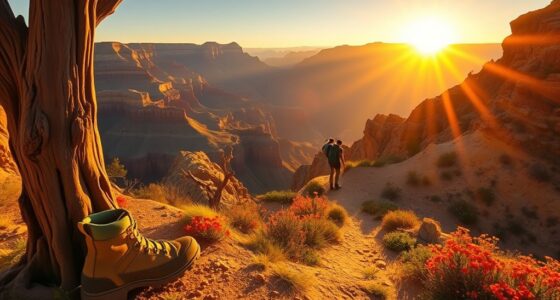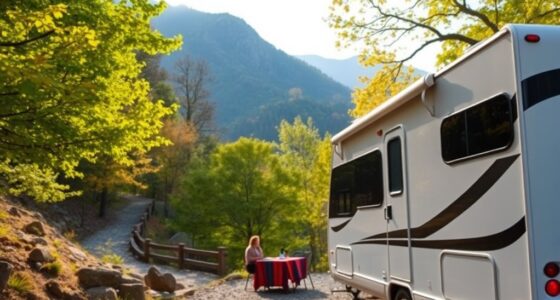When wildlife viewing in Joshua Tree National Park, remember to keep a safe distance—100 yards from large animals and 25 yards from smaller ones. The best times for spotting wildlife are during dawn and dusk. Use binoculars or zoom lenses for better looks without disturbing them. Avoid using flash for photography, stay on trails, and don’t feed the animals. Respecting these guidelines will enhance your experience and help preserve the park’s delicate ecosystem. There’s so much more to discover!
Key Takeaways
- Observe wildlife during dawn and dusk for the best chances to see active animals.
- Maintain a safe distance of at least 100 yards from large animals and 25 yards from smaller ones.
- Use natural light for photography and avoid using flash to prevent startling wildlife.
- Stay on designated trails and respect protected areas to preserve natural habitats.
- Never feed wildlife to prevent dependency and maintain their natural behaviors.

When you visit Joshua Tree National Park, you’re stepping into a unique ecosystem teeming with diverse wildlife. From the iconic roadrunners to the elusive desert tortoises, each species plays an essential role in this intricate web of life. While you’re excited to observe these creatures, it’s imperative to remember the importance of wildlife viewing etiquette. Respecting animal boundaries is fundamental, not just for your safety but for the well-being of the animals too.
Visiting Joshua Tree National Park offers a chance to witness diverse wildlife, but respecting their space is vital for both safety and their well-being.
As you explore the park, keep in mind that wildlife is most active during dawn and dusk. This is the best time for spotting animals, but it’s also when they’re most vulnerable. If you come across wildlife, maintain a safe distance. This means at least 100 yards from large animals like bighorn sheep and more than 25 yards from smaller creatures. Approaching too closely can stress them, disrupting their natural behavior and habitat. Use binoculars or a zoom lens on your camera to get a closer look without intruding.
When it comes to photography, you might be tempted to get that perfect shot. However, you should always follow photography guidelines that prioritize the well-being of the wildlife. Avoid using flash, as it can startle animals and disturb their natural activities. Instead, rely on natural light for your shots, capturing the beauty of these creatures in their environment. If you’re attempting to photograph a specific animal, resist the urge to chase or corner it for a better angle. Patience is key; wait for the moment to come to you.
Another critical aspect of wildlife viewing is to stay on designated trails. Venturing off-path can damage fragile habitats and disturb nesting areas. Additionally, it’s essential to respect any signs indicating protected zones or nesting sites. These areas are designated for the animals’ safety, and adhering to these guidelines helps preserve the ecosystem for future generations.
Lastly, remember that feeding wildlife is never a good idea. It can lead to animals becoming dependent on human food sources, which can harm their health and alter their natural behaviors. Enjoy the experience of observing wildlife in its natural habitat, but do so responsibly. By understanding wildlife viewing etiquette, you contribute to the conservation of these precious ecosystems.
Frequently Asked Questions
What Types of Wildlife Can I See in Joshua Tree National Park?
In Joshua Tree National Park, you can see a variety of native species, including bighorn sheep, coyotes, and desert tortoises. The park is also a fantastic spot for birdwatching, featuring hotspots where you might catch sight of roadrunners, cactus wrens, and various hawks. Keep your eyes peeled for the unique flora and fauna, and don’t forget your binoculars for an unforgettable wildlife experience!
Are There Specific Viewing Hours for Wildlife in the Park?
While there aren’t strict specific viewing hours for wildlife, you’ll find that wildlife activity times peak during the early morning and late evening. During park visitation hours, which typically run from sunrise to sunset, you’ll have the best chance of spotting critters in their natural habitat. So, set your sights and venture out during those golden hours to maximize your wildlife watching experience. Happy hunting!
Can I Bring My Pet While Wildlife Viewing?
You can’t bring your pet while wildlife viewing in most areas, as dog restrictions are in place to protect both wildlife and your pet’s safety. Many animals are sensitive to the presence of dogs, which can lead to stress or dangerous encounters. If you’re considering bringing your pet, check designated areas where pets are allowed and always prioritize their safety and the well-being of the wildlife around you.
Is Food Allowed While Observing Wildlife in the Park?
No, food isn’t allowed while you’re observing wildlife in the park. Feeding animals disrupts their natural behavior and can be harmful to them. If you’ve got snacks, make sure you’re storing food securely and away from any wildlife. It’s best to enjoy your meal at designated picnic areas instead. By keeping food out of sight, you help maintain a healthy environment for the animals and enhance your wildlife viewing experience.
How Should I Report Injured or Distressed Wildlife?
If you encounter injured or distressed wildlife, it’s vital to follow proper reporting procedures. First, keep a safe distance and avoid approaching the animal. Then, contact local wildlife rescue organizations or park authorities to report the situation. Provide as much detail as possible, like the species, location, and nature of the injury. Your prompt action can make a significant difference in helping the animal and ensuring it receives the care it needs.
Conclusion
By following proper wildlife viewing etiquette in Joshua Tree National Park, you help protect the delicate ecosystem and enhance your experience. Did you know that over 8 million visitors explore the park each year? By respecting the wildlife and their habitats, you contribute to the preservation of this stunning environment for future generations. So next time you’re out there, keep your distance, stay quiet, and remember: the beauty of nature is best enjoyed when we let it thrive undisturbed.










